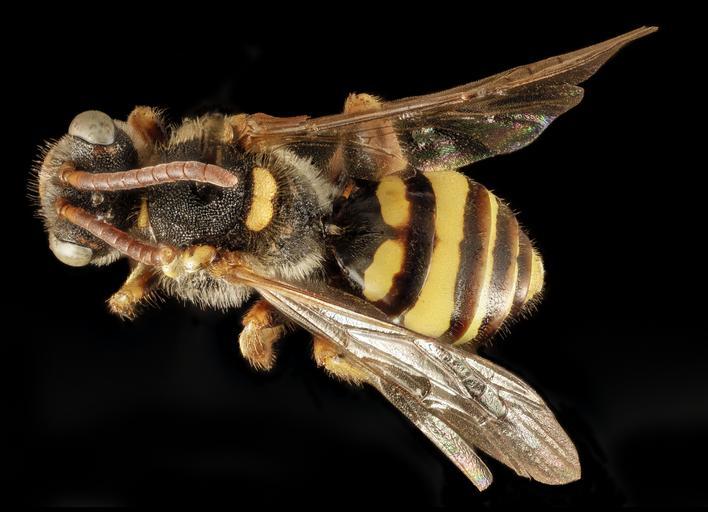MAKE A MEME
View Large Image

| View Original: | Mystery_Nomada,_f,_nj,_back_2015-05-04-07.01.08_ZS_PMax.jpg (4430x3202) | |||
| Download: | Original | Medium | Small | Thumb |
| Courtesy of: | www.flickr.com | More Like This | ||
| Keywords: nomada nomadine parasite nest parasite nestparasite cleptoparasite rare super rare superrare mystery new jersey newjersey bequeart mcz museum of comparative zoology museumofcomparativezoology bee bees hymenoptera story insect bug bugs taxonomy:genus=nomada great swamp national wildlife refuge greatswampnationalwildliferefuge droege biml usgs usgsbiml native bee nativebee black background animal photo border Ah, here is a good story, this is a shot of a female Nomada found at the museum of Comparative Zoology at Harvard. I have visited their museum many times, but only this last time did I find a synoptic collection of bees from New England that was separate from the rest of their large, lovely, and old collection of bees. In a little tray labeled "Nomada festiva" were two specimens, both females collected from northern New Jersey near Great Swamp NWR. No date, but the collector was the long-lived and productive past curator of invertebrates at the MCZ, Joseph Bequeart. So that means they could have been collected somewhere between the 20s and the 50's. N. festiva is an extremely rare species, only a few specimens. When I looked at the specimens I realized that while I was very familiar with the genus I had not recalled seeing anything like these. Long story short, they don't match the descriptions of N. festiva and they don't match any of the other possible candidate species. So, in a couple of weeks I will be traveling to Philadelphia Academy of Sciences to look at the type of N. festiva and N. sphaerogaster (vaguely keys to this one...also super rare and also unlikely to be this species). So it stands that these actually might be new species of Nomada and perhaps they are still around waiting to be rediscovered...this happens regularly because so few people actually bother to collect and preserve insect specimens any longer....so, get going will you? More pictures to come...but this is a start. ~~~~~~~~~~{{{{{{0}}}}}}~~~~~~~~~~ All photographs are public domain, feel free to download and use as you wish. Photography Information: Canon Mark II 5D, Zerene Stacker, Stackshot Sled, 65mm Canon MP-E 1-5X macro lens, Twin Macro Flash in Styrofoam Cooler, F5.0, ISO 100, Shutter Speed 200 Beauty is truth, truth beauty - that is all Ye know on earth and all ye need to know " Ode on a Grecian Urn" John Keats You can also follow us on Instagram account USGSBIML Want some Useful Links to the Techniques We Use? Well now here you go Citizen: Basic USGSBIML set up: www.youtube.com/watch?v=S-_yvIsucOY USGSBIML Photoshopping Technique: Note that we now have added using the burn tool at 50% opacity set to shadows to clean up the halos that bleed into the black background from "hot" color sections of the picture. www.youtube.com/watch?v=Bdmx_8zqvN4 PDF of Basic USGSBIML Photography Set Up: ftp://ftpext.usgs.gov/pub/er/md/laurel/Droege/How%20to%20Take%20MacroPhotographs%20of%20Insects%20BIML%20Lab2.pdf Google Hangout Demonstration of Techniques: plus.google.com/events/c5569losvskrv2nu606ltof8odo or www.youtube.com/watch?v=4c15neFttoU Excellent Technical Form on Stacking: www.photomacrography.net/ Contact information: Sam Droege sdroege@usgs.gov 301 497 5840 Ah, here is a good story, this is a shot of a female Nomada found at the museum of Comparative Zoology at Harvard. I have visited their museum many times, but only this last time did I find a synoptic collection of bees from New England that was separate from the rest of their large, lovely, and old collection of bees. In a little tray labeled "Nomada festiva" were two specimens, both females collected from northern New Jersey near Great Swamp NWR. No date, but the collector was the long-lived and productive past curator of invertebrates at the MCZ, Joseph Bequeart. So that means they could have been collected somewhere between the 20s and the 50's. N. festiva is an extremely rare species, only a few specimens. When I looked at the specimens I realized that while I was very familiar with the genus I had not recalled seeing anything like these. Long story short, they don't match the descriptions of N. festiva and they don't match any of the other possible candidate species. So, in a couple of weeks I will be traveling to Philadelphia Academy of Sciences to look at the type of N. festiva and N. sphaerogaster (vaguely keys to this one...also super rare and also unlikely to be this species). So it stands that these actually might be new species of Nomada and perhaps they are still around waiting to be rediscovered...this happens regularly because so few people actually bother to collect and preserve insect specimens any longer....so, get going will you? More pictures to come...but this is a start. ~~~~~~~~~~{{{{{{0}}}}}}~~~~~~~~~~ All photographs are public domain, feel free to download and use as you wish. Photography Information: Canon Mark II 5D, Zerene Stacker, Stackshot Sled, 65mm Canon MP-E 1-5X macro lens, Twin Macro Flash in Styrofoam Cooler, F5.0, ISO 100, Shutter Speed 200 Beauty is truth, truth beauty - that is all Ye know on earth and all ye need to know " Ode on a Grecian Urn" John Keats You can also follow us on Instagram account USGSBIML Want some Useful Links to the Techniques We Use? Well now here you go Citizen: Basic USGSBIML set up: www.youtube.com/watch?v=S-_yvIsucOY USGSBIML Photoshopping Technique: Note that we now have added using the burn tool at 50% opacity set to shadows to clean up the halos that bleed into the black background from "hot" color sections of the picture. www.youtube.com/watch?v=Bdmx_8zqvN4 PDF of Basic USGSBIML Photography Set Up: ftp://ftpext.usgs.gov/pub/er/md/laurel/Droege/How%20to%20Take%20MacroPhotographs%20of%20Insects%20BIML%20Lab2.pdf Google Hangout Demonstration of Techniques: plus.google.com/events/c5569losvskrv2nu606ltof8odo or www.youtube.com/watch?v=4c15neFttoU Excellent Technical Form on Stacking: www.photomacrography.net/ Contact information: Sam Droege sdroege@usgs.gov 301 497 5840 | ||||